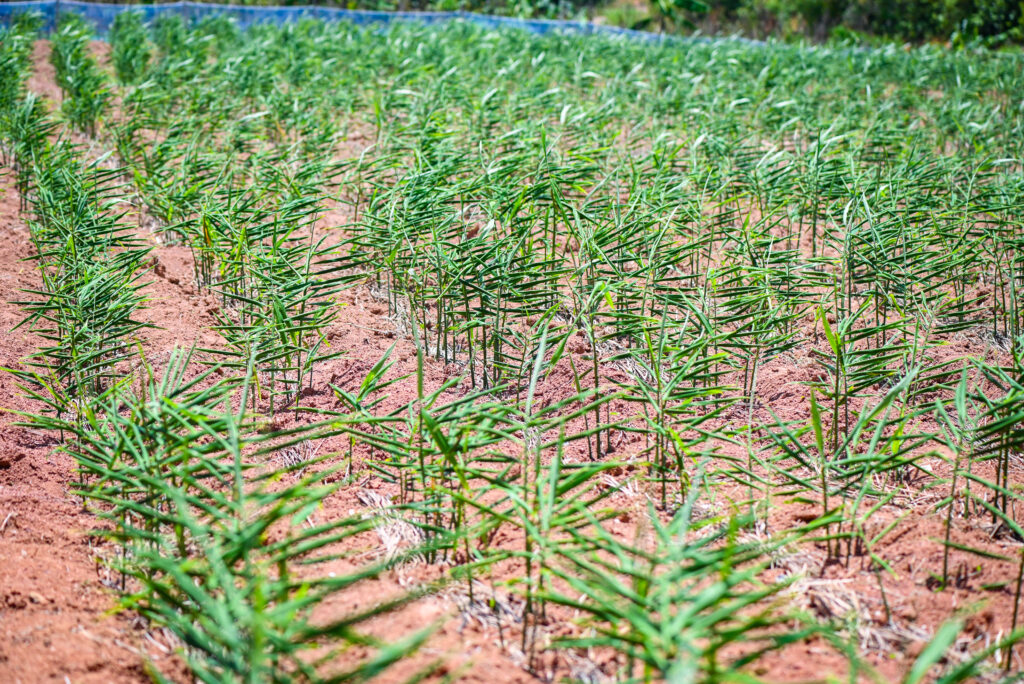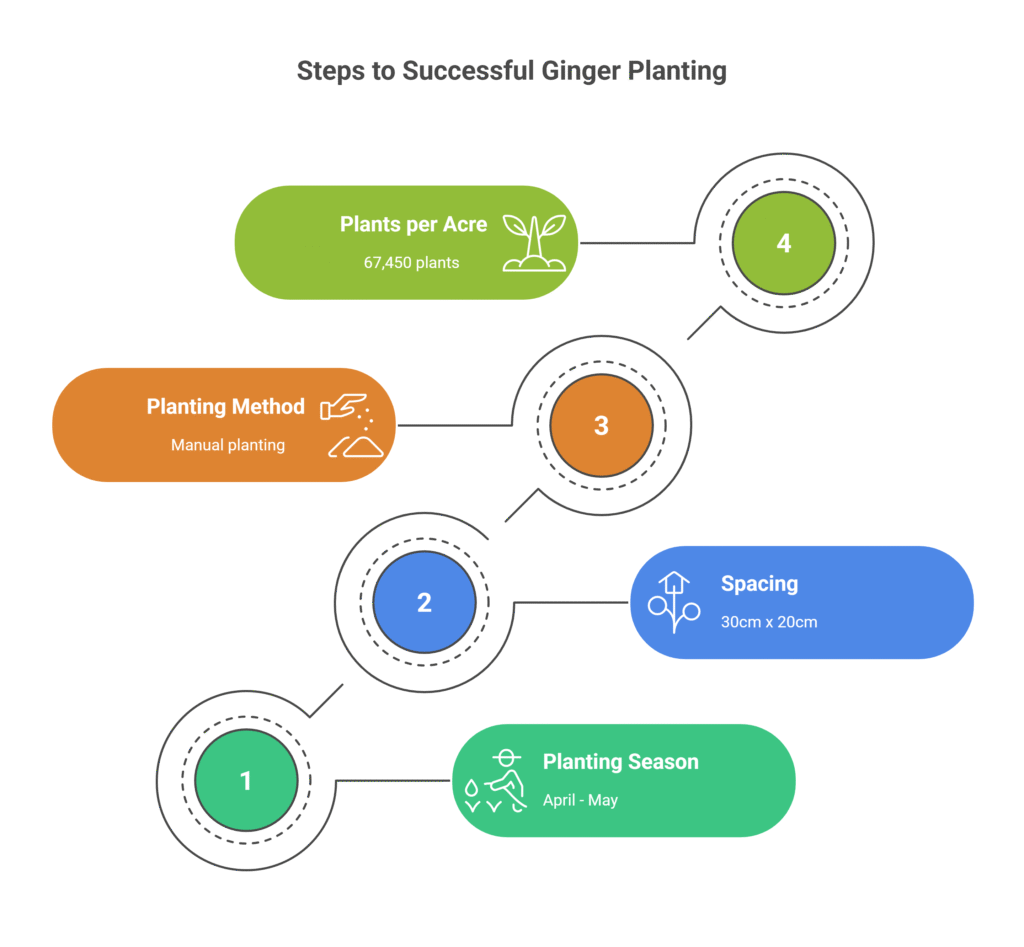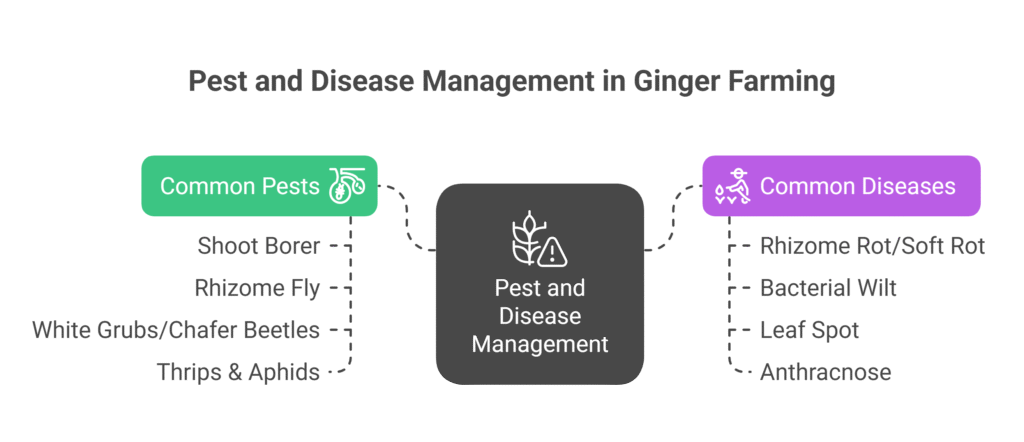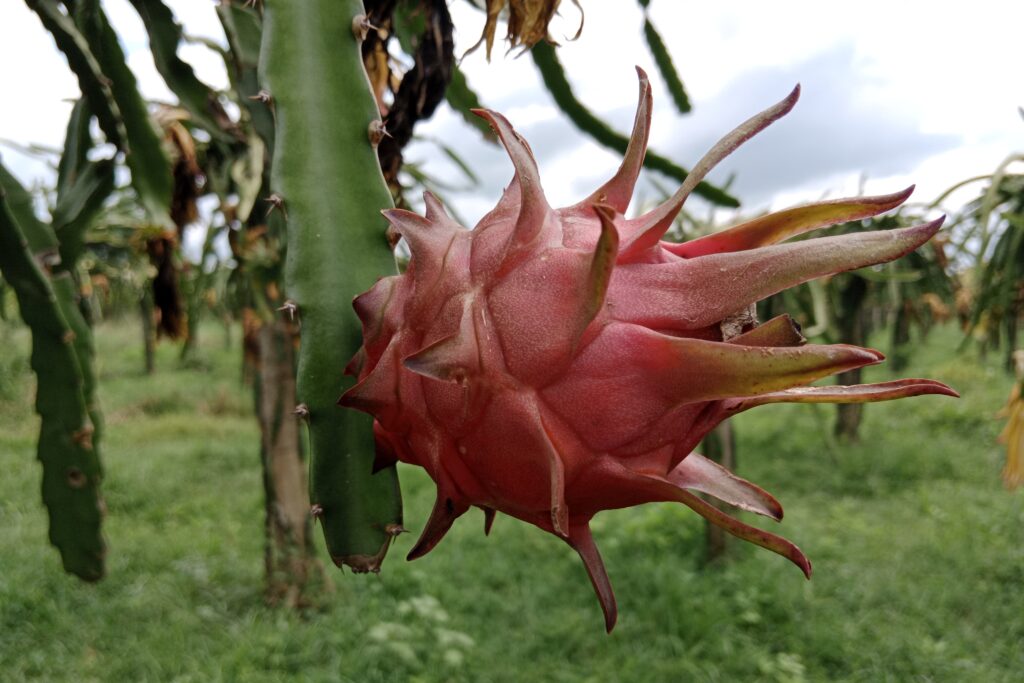Ginger Farming
Ginger (Zingiber officinale) is a tropical rhizome crop prized for its culinary, medicinal, and aromatic properties. Ginger farming can be highly profitable, with a total income of NRs. 300,000 per acre against a total production cost of NRs. 68,000. This results in a net profit of NRs. 232,000 per acre, highlighting the impressive Ginger Farming Profit Per Acre. The high profitability is further emphasized by a remarkable Return on Investment (ROI) of 341%, meaning every rupee invested yields a return of over three times the cost.

Land Preparation
Land preparation for ginger cultivation involves several crucial steps to ensure optimal rhizome development and plant health. Begin with 2–3 deep plowings (30–40 cm) to thoroughly loosen the soil, which enhances aeration and drainage, essential for ginger’s horizontal rhizome growth. 3–4 harrowings follow this to achieve a fine, friable, clod-free tilth, and precise leveling to promote uniform water distribution and prevent waterlogging, which can severely damage the crop.
Raised beds should then be constructed, typically 20–30 cm high and 1–1.2 m wide, with 30–40 cm wide furrows between them to facilitate proper drainage, support healthy root and rhizome development, and allow easy earthing-up. During the final preparation stage, incorporate 20–25 tons per acre of well-decomposed organic matter such as farmyard manure or compost into the top 20–25 cm of soil to improve fertility and soil structure.
Soil Type
Ginger thrives in deep, well-drained, loose, friable loamy soils rich in organic matter, with sandy loam also being suitable, provided water retention is carefully managed.
Drainage is absolutely paramount because ginger is extremely susceptible to rhizome rot under waterlogged conditions; consequently, heavy clay soils are unsuitable unless heavily amended, and low-lying or poorly drained fields must be avoided.
For optimal growth, ginger prefers a slightly acidic soil pH ranging from 5.5 to 6.5, as soils above pH 7.0 (alkaline) hinder development and micronutrient uptake, meaning lime is generally unnecessary while sulfur may be required to lower the pH if needed.
Climatic Requirements
| Parameter | Requirements | Notes/Details |
| Temperature | True tropical plant requiring warm, humid conditions | |
| Optimal Growth: 25°C to 30°C (77°F to 86°F) | ||
| Critical Minimum: Below 20°C (68°F) | Growth ceases; Frost is fatal | |
| Critical Maximum: Above 35°C (95°F) | Growth slows significantly; Scorching can occur | |
| Rainfall/Humidity | High humidity (70-90%) and consistent rainfall | Rainfall: 1500-3000 mm (60-120 inches) per year, well-distributed |
| Irrigation essential during dry spells, especially during rhizome development | ||
| Shade | Benefits from 25-50% partial shade | Especially important during hot summer months |
| Can be provided by: Agroforestry (e.g., banana, coconut, Gliricidia, Erythrina) or artificial shade nets | ||
| Benefits: Reduces leaf scorch and conserves soil moisture |
Major Cultivars
Major cultivars of ginger are selected based on their intended end-use—whether for fresh consumption, drying, oil extraction, or oleoresin production—as well as factors like maturity duration, yield potential, disease resistance, and fiber content. Notable varieties include Maran, Nadia, Rio de Janeiro, Varada, Mahima, Suprabha, Surabhi, Himagiri, IISR Rejatha, IISR Mahima, and IISR Varada.
Seed Rate per Acre
For ginger cultivation, select healthy, disease-free rhizomes—both mother rhizomes and fingers—for planting, using a seed rate of 600–720 kg per acre. Before sowing, treat the rhizomes by immersing them in a Mancozeb solution (3 grams per liter of water) for 30 minutes to prevent fungal infections. After treatment, shade-dry the rhizomes for 3–4 hours. Once dried, mix the seed rhizomes with well-rotted cattle manure or compost inoculated with Trichoderma (10 grams of Trichoderma per kilogram of compost) to enhance disease resistance and promote healthy growth.
Planting
a) Planting Season
Ginger is best planted during April–May, when soil temperatures rise to at least 20°C (68°F) and the onset of rains begins. In tropical regions with access to irrigation, planting can be done throughout the year, although spring remains the most favorable season for optimal growth.

b) Spacing
Ginger should be planted with rows spaced 30 cm apart and individual setts placed 20 cm apart within the rows. The setts should be planted at a depth of 3–5 cm, ensuring that the buds are facing upwards to promote proper sprouting and growth.
c) Planting Method
Planting of ginger is primarily done by hand to ensure precise placement and correct orientation of the buds facing upward, which is critical for uniform sprouting. Although small tractor-drawn ginger planters are available, their use remains limited due to the delicate nature of the planting process.
d) Number of Plants per Acre
An estimated 67,450 ginger plants may be grown per acre, according to the above spacing.
Intercropping
| Aspect | Details |
| Suitability | Ginger is ideal for intercropping due to slow early growth and partial shade tolerance. |
| Suitable Companions | Turmeric – Maize (provides shade) – Onion – Chilli – Castor – Pulses (e.g., pigeon pea – provides shade & fixes nitrogen) – Banana, Coconut, Arecanut (in mature plantations) |
| Unsuitable Crops | Heavy feeders or tall crops that create excessive shade later in the season. |
| Benefits | Efficient land use – Additional income – Weed suppression – Shade provision by taller companions – Risk diversification |
Irrigation
Irrigation is essential in ginger cultivation during germination, active tillering, and rhizome development. Maintain consistently moist soil, irrigating immediately after planting and every 7–10 days during dry spells, with higher frequency in sandy soils or hot weather.
Drip irrigation is preferred for efficiency and disease prevention, while furrow irrigation is also used; avoid overhead sprinklers. Reduce watering gradually 1–2 months before harvest and stop completely 1–2 weeks prior to harvesting to enhance rhizome quality.
Although ginger is often grown as a rainfed crop, irrigation should be adjusted according to rainfall patterns. Mulch with green leaves at 50 quintals per acre after planting and repeat with 20 quintals per acre after each fertilizer application to retain moisture and suppress weeds.
Fertilizer and Manure
Ginger has a high nutrient demand, particularly for potassium, making proper fertilization essential for healthy growth and yield. Earthing-up is a critical practice performed after each top dressing of fertilizer, typically at 45–60 and 90–120 days after planting (DAP).
This involves drawing soil around the base of the plants to cover developing rhizomes, enhance drainage, suppress weed growth, and provide plant support. Earthing-up should be repeated 2–3 times during the crop cycle for best results.
| Component | Application Rate | Timing/Splits | Additional Notes |
| Organic Matter | 10–15 tons/acre | During land preparation | Well-decomposed FYM or compost |
| Nitrogen (N) | 30 kg/acre | • 1/3 as basal dose • 1/3 at 45–60 DAP (after sprouting/tillering) • 1/3 at 90–120 DAP (rhizome initiation) | |
| Phosphorus (P₂O₅) | 20 kg/acre | Entire dose as basal application at planting | |
| Potassium (K₂O) | 20 kg/acre | • 1/2 as basal dose • 1/2 at 90–120 DAP (rhizome development phase) | |
| Micronutrients | • Zinc (ZnSO₄): 10 kg/acre • Boron (Borax): 5 kg/acre • Magnesium (MgSO₄): 20 kg/acre | Based on soil test | Often applied as foliar sprays |
Weed Control
Weed control is crucial during the first 3–4 months of ginger cultivation due to the crop’s slow early growth and high weed competition. Mulching with 8–10 cm of organic material like green leaves, straw, or compost is highly effective for conserving moisture, suppressing weeds, and improving soil health.
It should be applied immediately after planting and replenished as needed. Shallow cultivation between rows and hand weeding around plants help manage weeds without damaging roots or rhizomes. Herbicides such as Pendimethalin or Oxyfluorfen may be used cautiously as pre-emergence treatments under expert guidance, but post-emergence options are limited and should be applied with care.
Flowering and Fruit Management
Flowering in ginger is uncommon in commercial cultivars grown for rhizomes and typically occurs only under specific conditions or in ornamental varieties, where cone-like inflorescences appear on separate stalks.
Since flowering diverts energy away from rhizome development, it is important to remove flower buds as soon as they appear by cutting the stalk close to the base. This practice ensures that the plant’s resources are fully directed toward producing larger and more productive rhizomes. Ginger is propagated vegetatively through rhizomes, and true seed production holds no commercial significance.
Pest and Disease Management
Common Pests
a) Shoot Borer
Larvae of shoot borer penetrate into plant stems, resulting in wilting and a reduction in the general health of the plant. Effective management of this pest involves removing affected shoots, setting up pheromone traps, and applying Neem oil sprays or pesticides like Quinalphos (2.5 ml/L) or Dimethoate (2 ml/L) when necessary.
b) Rhizome Fly
If an infestation of rhizome fly is observed in the field, it can be effectively managed by spraying Acephate 75SP at 15 grams per 10 liters of water, with the application repeated at 15-day intervals for sustained control.
c). White Grubs/Chafer Beetles
The larvae feed on roots and rhizomes, causing significant damage to the crop. Effective control measures include deep plowing to expose larvae, installation of light traps to attract adult beetles, application of neem cake, and soil drenching with insecticide such as Profenofos at 2 ml per liter of water.
d) Thrips & Aphids
These pests harm plants by consuming their fluids, which results in stunted development and decreased output. Systemic pesticides such as imidacloprid or acetamiprid at a rate of 1 milliliter per liter of water, Neem oil, or insecticidal soap are examples of control methods. For efficient control of these sucking pests, neem-based pesticides like Azadirachtin 0.3EC, applied at a rate of 2 milliliters per liter of water, can also be utilized.

Common Diseases
a). Rhizome Rot/Soft Rot
Rhizome Rot/Soft Rot is one of the most destructive diseases that causes rhizomes to wilt, yellow, and decay. The use of disease-free seed treatment, good drainage through raised beds, extended crop rotations of three to four years, and preventing waterlogging are all necessary for effective control. Soil drenches containing fungicides like Metalaxyl (1.25 gm/L) or Mancozeb (3 gm/L) applied 30, 60, and 90 days after planting, as well as the application of bio-agents like Trichoderma and Pseudomonas, also aid in preventing rot in the roots and rhizomes.
b) Bacterial Wilt
Bacterial Wilt leads to sudden wilting, vascular browning, and rhizome rot. Effective management involves strict sanitation, long crop rotations of five years or more, using disease-free seeds and resistant cultivars, and avoiding infected fields. Once the disease is detected, drenching plants with Copper oxychloride at 3 gm per liter of water combined with streptomycin sulphate at 0.5 gm per liter is recommended to prevent its spread.
c) Leaf Spot
Leaf spot infestation manifests as brown spots on leaves and can be managed by spraying either Mancozeb (30 gm per 10 liters of water) or Carbendazim (10 gm per 10 liters of water), alternating between these fungicides every 15–20 days for effective control; alternatively, apply Propiconazole at 1 ml per liter of water to suppress disease spread and maintain healthy crop growth. Consistent monitoring and timely fungicide applications are critical for successful disease management.
d) Anthracnose
Anthracnose infestation can be controlled by spraying Hexaconazole at 10 ml or Mancozeb 75WP at 25 gm per 10 liters of water along with 10 ml of sticker to ensure better adherence and effectiveness of the treatment.
Harvesting
| Timing | Green Ginger: Harvest 5–6 months after planting for fresh, tender rhizomes with milder flavor and higher moisture; tops remain green. – Mature Ginger: Harvest 8–10 months after planting when leaves yellow and start drying; rhizomes become pungent, fibrous, and suitable for drying or storage. |
| Signs of Maturity | Leaves turn yellow, stems begin to dry and lodge (fall over). |
| Method | Carefully loosen soil around clump using a spade or fork, lift the entire clump gently, shake off excess soil, avoiding bruising or cutting rhizomes. |
| Handling | Handle rhizomes gently to minimize damage and prevent rot during storage. |
Yield
Yield varies widely based on factors such as cultivar, climate, soil fertility, management intensity, and crop duration. Under good management conditions, fresh rhizome yields typically range from 6 to 10 tons per acre, while dry ginger yield accounts for approximately 15–25% of the fresh weight.
Post-Harvest
Post-harvest management involves several critical steps to maintain ginger quality. First, wash the rhizomes gently with water to remove soil, avoiding soaking. For storage, dry the cleaned rhizomes in the sun for 5–7 days until the skin hardens and wrinkles, while protecting them from rain and dew; artificial drying at 50–60°C is used commercially.
Peeling or polishing may be done for fresh markets or specific products like white ginger. For storage, dried ginger should be kept in cool (12–14°C), dry (60–70% RH), well-ventilated, and rat-proof conditions such as bins or silos. Fresh ginger intended for immediate sale can be stored for 2–3 weeks at 12–14°C with high humidity (90–95%).
Cost of Investment per Acre for Ginger Farming
| S.N. | Categories | Cost of Investment (NRs.) |
| 1 | Land Preparation (Plowing) | 15,000 |
| 2 | Seed or Rhizome | 18,000 |
| 3 | Planting | 5,000 |
| 4 | Fertilizers and Manure | 10,000 |
| 5 | Irrigation | 5,000 |
| 6 | Weed Control (Pre & Post-emergence) | 4,000 |
| 7 | Pest & Disease Control | 3,000 |
| 8 | Harvesting | 5,000 |
| 9 | Miscellaneous Costs | 3,000 |
| Total Cost | 68,000 |
Income from Per Acre Ginger Farming
| Particulars | Estimated Yield/acre (Kg) | Market Price (NRs. /Kg) | Total Income (NRs.) |
| Ginger Yield | 6,000 | 50 | 300,000 |
Analysis of Ginger Farming Profit Per Acre
| Description | Amount (NRs.) |
| Total Income | 300,000 |
| Total Cost | 68,000 |
| Net Profit | 232,000 |
| Return on Investment (ROI) | 341% (Profit ÷ Cost × 100) |

Ginger farming can be highly profitable, with a total income of NRs. 300,000 per acre against a total production cost of NRs. 68,000. This results in a net profit of NRs. 232,000 per acre, making it an attractive venture for commercial cultivation. The high profitability is further emphasized by a remarkable Return on Investment (ROI) of 341%, meaning every rupee invested yields a return of over three times the cost.
Crop Calendar for Ginger Farming
| Growth Stage | Timing | Key Operations | Details |
| Land Preparation | Feb – Mar | Deep plowing (2-3 times), harrowing (3-4 times), bed formation, organic matter incorporation | 20-25 tons/acre FYM/compost; raised beds (20-30 cm height, 1-1.2 m width). |
| Seed Treatment | Late Mar – Early Apr | Rhizome selection, fungicide treatment, Trichoderma inoculation | 600–720 kg/acre seed rate; Mancozeb (3g/L) dip; shade-dry 3-4 hrs. |
| Planting | Apr – May | Sett placement (buds upward), spacing, mulching | 30 cm row × 20 cm plant spacing; 3–5 cm depth; mulch: 50 q/acre green leaves. |
| Basal Fertilization | At planting | Apply N (10 kg/acre), P (20 kg/acre), K (10 kg/acre) | Split N/K: 1/3 N + full P + 1/2 K as basal dose. |
| Early Growth | May – Jun | Irrigation, weed control, pest monitoring | Irrigate every 7–10 days; mulch replenishment; monitor shoot borer/aphids. |
| First Top Dressing | 45–60 DAP (Jun) | N application (10 kg/acre), earthing-up | Earthing-up: cover rhizomes, improve drainage. |
| Second Top Dressing | 90–120 DAP (Jul-Aug) | N (10 kg/acre) + K (10 kg/acre), earthing-up | Critical for rhizome development; repeat earthing-up. |
| Mid-Season Mgmt | Jun – Sep | Disease/pest control, irrigation, intercropping maintenance | Spray for rhizome rot/leaf spot; maintain shade (25-50%); manage intercrops. |
| Water Withdrawal | 1–2 months pre-harvest | Gradual irrigation reduction | Stop irrigation 1–2 weeks before harvest. |
| Green Harvest | Sep – Oct (5–6 MAP) | Harvest tender rhizomes | For fresh market; milder flavor; leaves still green. |
| Mature Harvest | Dec – Feb (8–10 MAP) | Harvest when leaves yellow/dry | Rhizomes pungent, fibrous; lift clumps gently; avoid bruising. |
Sources
Tamil Nadu Agricultural University (TNAU) Agritech Portal
Food and Agriculture Organization (FAO)
Indian Council of Agricultural Research (ICAR)
Nepal Agricultural Research Council (NARC)



Very educative well prepared in a simple language.